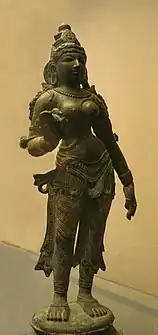Bhūmi
Bhūmi, also known as Bhudevi and Bhūma-Devī, is the Hindu goddess representing Mother Earth. Bhumi is the consort of Varaha, boar-avatar of the god Vishnu. She was also the mother of Narakasura and Mangala. Goddess Sita was born from the earth, thus she was Bhumi's spiritual daughter.[1]
| Bhūmi | |
|---|---|
The goddess of Earth | |
| Member of The Pancha Bhoota | |
.jpg.webp) Sculpture of Bhūmi | |
| Other names | Bhudevi, Prithvi, Puhumi, Vasundhara |
| Affiliation | Devi, Lakshmi, Pancha Bhoota |
| Abode | Bhuloka, Vaikuntha and Dyuloka |
| Mantra | Om Bhumyai namah |
| Mount | Cow or Elephant |
| Personal information | |
| Consort | Varaha (Vishnu) |
| Children | Narakasura, Mangala and Sita (according to Ramayana) |
Etymology and iconography

The name "Bhumi" derives from the Sanskrit word 'Puhumi' - the original name of the goddess. She is known by various names such as Bhuvati, Bhuvaani, Bhuvaneshwari, Avni, Prithvi, Varahi, Dharti, Dhaatri, Dharani, Vasudha, Vasundhara, Vaishnavi, Kashyapi, Urvi, Ira, Mahi, Ela, Vasumati, Dhanshika, Hema and Hiranmaya.
Bhudevi is depicted as seated on a platform which rests on the back of four elephants, representing the four directions of the world. She is usually depicted with four arms, respectively holding a pomegranate, a water vessel, a bowl containing healing herbs, and another bowl containing vegetables.[2] She is also sometimes depicted with two hands, the right hand holding a blue lotus known as Kumuda or Utpala, the night lotus, while the left hand may be in the Abhayamudra, the fearlessness or the Lolahasta Mudra, which is an aesthetic pose meant to mimic the tail of a horse.[3][4]
Consort and children
Bhudevi is the consort of the boar god Varaha, an avatar of Vishnu.[5] In Satya Yuga, the demon Hiranyaksha kidnapped the earth and hid her in the primordial waters, Vishnu appeared as Varaha to rescue her. Varaha slew the demon and retrieved the Earth from the ocean, lifting it on his tusks, and restored Bhudevi to her place in the universe and married her. Mangala was the son of Varaha and Bhumi.[6][7]
Narakasura was the first born of Bhudevi. There are two stories about Narakasura's birth. In the first one, he was the first son of Bhumi and Varaha. He was born when Bhūmi requested Varaha for a son. Narakasura later did a penance to received a boon that only his mother would be able to kill him. In the second one, Narakasura's father is Hiranyaksha and was born when Hiranyaksha's horns touched Bhumi.[8]
Sita, the wife of Rama emerged from the earth, thus Bhumi is her spiritual mother. Once, there was a drought in Mithila, hometown of Sita. Janaka, father of Sita was ploughing the ground. Under his plough, he found a baby girl (Sita). After which, rain showered and Janaka and wife, Sunaina, decided to adopt the girl. As Sita was born from the earth, she was also known as Bhumija.[9]

Satyabhama avatar
After receiving the boon, Narakasura became arrogant and proud of his power. He started capturing women and made them his wives forcefully. He captured nearly 16 thousand women. He took the control of heaven from Indra and no one was able to defeat him because of his boon. Narakasura even took the earrings of Lord Indra's mother, Goddess Aditi and gave it to his mother, Bhumi. Bhūmi was requested to kill him. She took an avatar as Satyabhama, daughter of Satrajit. Satyabhama married Krishna and they killed Narakasura.[10]
References
| Wikimedia Commons has media related to Bhūmi. |
- www.wisdomlib.org (2019-01-28). "Story of Bhūmi". www.wisdomlib.org. Retrieved 2020-09-09.
- T.A.G. Rao (1997). Elements of Hindu Iconography. Motilal Banarsidass. ISBN 81-208-0876-2.
- Margaret Stutley (2003). The Illustrated Dictionary of Hindu Iconography. Munshiram Manoharlal Publishers. p. 82. ISBN 81-215-1087-2.
- A. G. Mitchell; Victoria and Albert Museum (1982). Hindu gods and goddesses. United Kingdom: Her Majesty's Stationery Office. p. 8. ISBN 9780112903727.
- "Killing of Narakasura".
- Dalal, Roshen (2010). Hinduism: An Alphabetical Guide. Penguin Books India. ISBN 978-0-14-341421-6.
- "Bhoomi Devi – Our Sacred Goddess Mother Earth". Anaadi Foundation Blog. Retrieved 2020-09-09.
- Dalal, Roshen (2010). Hinduism: An Alphabetical Guide. Penguin Books India. ISBN 978-0-14-341421-6.
- "The Story of Mother Sita the consort of Rama". Salagram.net. Archived from the original on 30 May 2012. Retrieved 18 March 2012.
- "Happy Diwali: The Legends Linked To Deepavali Festival". NDTV.com. Retrieved 2020-06-09.
